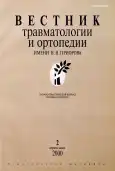Biomechanical assessment of the support ability of the lower limbs in patients with fractures of the bones of the lower leg in the treatment of transosseous osteosynthesis
- Authors: Negreeva M.B.1, Solomin L.N.1
-
Affiliations:
- Institute of Traumatology and Orthopedics, Scientific Center for Reconstructive and Reconstructive Surgery, Siberian Branch of the Russian Academy of Medical Sciences
- Issue: Vol 7, No 2 (2000)
- Pages: 68-72
- Section: Original study articles
- URL: https://journals.rcsi.science/0869-8678/article/view/104256
- DOI: https://doi.org/10.17816/vto104256
- ID: 104256
Cite item
Full Text
Abstract
In 17 patients with diaphyseal shin fractures treated by transosseous osteosynthesis the weight bearing ability was studied at standing and walking. Immediately after transosseous osteosynthesis in all patients the weight bearing was shown to be present both at standing and at walking with crutches. Then the weight bearing load on the operated limb at standing was increased to a greater degree compared to the duration of weight bearing on the operated limb at walking. By the end of fixation period the load of weight bearing on the operated limb at standing was almost normal, but the time of weight bearing on the operated limb remained 1.6 times below the norm. The stages of weight bearing ability were distinguished as following: I-st stage - adaptation (immediately after operation up to 1.5 months), ІІ-nd stage -stabilization (from 1.5 months to the end of fixation period). The period from 1.5 months ±0.2 months after operation was conditionally defined as the beginning of weight bearing ability.
Keywords
Full Text
##article.viewOnOriginalSite##About the authors
M. B. Negreeva
Institute of Traumatology and Orthopedics, Scientific Center for Reconstructive and Reconstructive Surgery, Siberian Branch of the Russian Academy of Medical Sciences
Author for correspondence.
Email: info@eco-vector.com
Russian Federation, Irkutsk
L. N. Solomin
Institute of Traumatology and Orthopedics, Scientific Center for Reconstructive and Reconstructive Surgery, Siberian Branch of the Russian Academy of Medical Sciences
Email: info@eco-vector.com
Russian Federation, Irkutsk
References
- Барабаш А.П., Соломин Л.Н. //Травматол. ортопед. России. — 1995. — N 4. — С. 52-56.
- Бурматов Е.А., Голубъ С.Н. //Гений ортопедии. — 1996. — N 2-3. — С. 32-33.
- Кочнев В.Л. //Там же. — С. 43-44.
- Кудрин Б.И., Голиков В.Д. //Ортопед. травматол. — 1977. — N 1. — С. 41-45.
- Мителева З.М. и др. //Методы повышения информативности статографических исследований в травматологии и ортопедии: Тезисы докладов II Всесоюз. конф. — Рига, 1979. — Т. 4. — С. 46-48.
- Мухаметов Ф.В. и др. //Гений ортопедии. — 1996.— N 2-3. — С. 50-51.
- Мякотина Л.И., Розенштейн Б.С., Ваганова И.П. //Вопросы биомеханики в травматологии и ортопедии. — Л., 1978. — Вып. 15. — С. 3-9.
- Николаев Л.П. Руководство по биомеханике в применении к ортопедии. — Киев, 1947. — Т. 1.
- Никоненко Н.Г. //Протезирование и протезостроение. — М., 1960. — Вып. 2. — С. 117-121.
- Скворцов Д.В. Клинический анализ движений. Анализ походки. — Иваново, 1996.
- Соломин Л.Н. Управляемый комбинированный остеосинтез длинных костей: разработка, обоснование, клиническое применение: Автореф. дис. ... д-ра мед. наук. — Иркутск, 1996.
- Тишков Н.В. Лечение закрытых диафизарных переломов костей голени методом чрескостного остеосинтеза в регионе с малой плотностью населения: Автореф. дис. ... канд. мед. наук. — Иркутск, 1995.
- Чирсков М.Я. //III Науч. сессия ЦНИИПП. — М., 1952. — С. 49-52.
- Щуров В.А., Горбачева Л.Ю. //Тезисы докладов III Всерос. конф. по биомеханике. — Н. Новгород, 1996.— Т. 2. — С. 202-203.
Supplementary files









